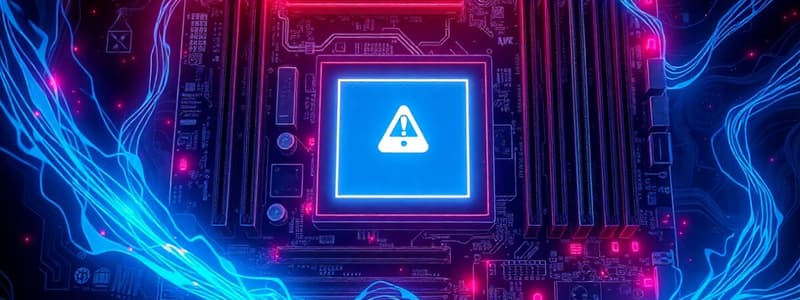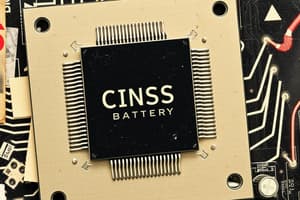Podcast
Questions and Answers
What should you do immediately if you see or smell smoke in an electrical system?
What should you do immediately if you see or smell smoke in an electrical system?
- Inspect the motherboard for damage.
- Turn the system off. (correct)
- Continue using the system cautiously.
- Check for loose connections.
What is a possible cause of electricity not flowing correctly in a system?
What is a possible cause of electricity not flowing correctly in a system?
- A short-circuit on the motherboard. (correct)
- Cooling system failure.
- High RAM usage.
- A fully seated connector.
What happens when you see or smell smoke coming from an electrical component?
What happens when you see or smell smoke coming from an electrical component?
- It can usually be repaired easily.
- It indicates that components may need replacement. (correct)
- It suggests that power issues are resolved.
- It's a sign of normal operation.
Which of the following is NOT mentioned as a common issue with computer components?
Which of the following is NOT mentioned as a common issue with computer components?
What is the risk associated with a connector that isn't seated properly in an electrical system?
What is the risk associated with a connector that isn't seated properly in an electrical system?
What might happen if the power supply cannot deliver the required DC electricity to the system?
What might happen if the power supply cannot deliver the required DC electricity to the system?
What does pin 8 on the power supply connector connect to on the motherboard?
What does pin 8 on the power supply connector connect to on the motherboard?
Which voltage indicates that the power supply may be failing if it reads below this threshold?
Which voltage indicates that the power supply may be failing if it reads below this threshold?
How does the PC check for hardware functionality during the boot process?
How does the PC check for hardware functionality during the boot process?
What is a common symptom of a bad power supply under certain failure conditions?
What is a common symptom of a bad power supply under certain failure conditions?
What does the system do if the power good wire loses power during operation?
What does the system do if the power good wire loses power during operation?
How can boot error codes be reported after a problem is detected during the POST phase?
How can boot error codes be reported after a problem is detected during the POST phase?
What steps should you take if you determine the power supply is failing?
What steps should you take if you determine the power supply is failing?
What does three beeps, two beeps, and four beeps typically indicate?
What does three beeps, two beeps, and four beeps typically indicate?
What does a 201 error code typically indicate after the POST?
What does a 201 error code typically indicate after the POST?
What is a POST card primarily used for?
What is a POST card primarily used for?
What do distended capacitors on a motherboard typically indicate?
What do distended capacitors on a motherboard typically indicate?
What is the most common reason for losing BIOS or UEFI settings?
What is the most common reason for losing BIOS or UEFI settings?
What can result from excessive dust buildup in a computer system?
What can result from excessive dust buildup in a computer system?
What feature is included in most motherboards to prevent damage from excessive temperature?
What feature is included in most motherboards to prevent damage from excessive temperature?
What is the first step when diagnosing intermittent device failure?
What is the first step when diagnosing intermittent device failure?
What should you be cautious about when experiencing thermal shutdown?
What should you be cautious about when experiencing thermal shutdown?
What should you do if you encounter smoke or a burning smell from a computer?
What should you do if you encounter smoke or a burning smell from a computer?
What could be a symptom of a failing fan in a computer system?
What could be a symptom of a failing fan in a computer system?
How can one dynamically monitor a computer's internal temperature during operation?
How can one dynamically monitor a computer's internal temperature during operation?
What commonly causes overheating in a computer system?
What commonly causes overheating in a computer system?
Which issue may arise from a bad motherboard battery?
Which issue may arise from a bad motherboard battery?
Flashcards
Power Supply Issues
Power Supply Issues
Problems with the power supply's ability to provide the needed DC electricity for the system.
Power Supply Failure Symptoms
Power Supply Failure Symptoms
Unexpected system shutdowns, continuous reboots, or failure to power on.
Power Good Wire
Power Good Wire
A crucial wire on the motherboard that receives power signal from the power supply.
Power Supply Voltage Tests
Power Supply Voltage Tests
Signup and view all the flashcards
Power-On Self-Test (POST)
Power-On Self-Test (POST)
Signup and view all the flashcards
Boot Error Codes
Boot Error Codes
Signup and view all the flashcards
Error Reporting Methods
Error Reporting Methods
Signup and view all the flashcards
Smoke/Smell of Smoke
Smoke/Smell of Smoke
Signup and view all the flashcards
Electrical Problem Symptom
Electrical Problem Symptom
Signup and view all the flashcards
Short Circuit
Short Circuit
Signup and view all the flashcards
Motherboard Issues
Motherboard Issues
Signup and view all the flashcards
Component Replacement
Component Replacement
Signup and view all the flashcards
Beep Codes
Beep Codes
Signup and view all the flashcards
Error Codes
Error Codes
Signup and view all the flashcards
POST Card
POST Card
Signup and view all the flashcards
Distended Capacitors
Distended Capacitors
Signup and view all the flashcards
CMOS Power Loss
CMOS Power Loss
Signup and view all the flashcards
System Overheating
System Overheating
Signup and view all the flashcards
Intermittent Device Failure
Intermittent Device Failure
Signup and view all the flashcards
Smoke/Burning Smell
Smoke/Burning Smell
Signup and view all the flashcards
Temperature Monitoring
Temperature Monitoring
Signup and view all the flashcards
Study Notes
Motherboard Troubleshooting
-
Power Issues:
- Power supplies degrade over time, especially with overheating or overload.
- Insufficient power delivery can lead to system shutdown, continuous rebooting, or no power-on.
- Pin 8 on the power supply connector connects to the power good wire on the motherboard. Loss of power on this wire causes shutdown.
- Rapid power return can trigger reboots.
- Insufficient voltage on this wire prevents booting.
-
Power Supply Testing:
- Verify power supply as the source of the problem.
- Test voltage output on motherboard or hard drive connectors.
- Voltage below 11V on a 12V wire suggests a faulty power supply.
- Replace the power supply if voltage is low.
-
Boot Errors:
- POST (Power-On Self-Test) checks basic hardware during boot.
- Problems during POST generate error reports.
- Error reporting methods: audible beeps, numeric codes, error messages.
- Motherboard documentation is needed for beep codes.
-
Boot Beep Codes:
- Screen-displayed errors are easier to diagnose than beep codes.
- Different beep combinations signify different hardware failures (e.g., 3-2-4 = keyboard failure).
- Consult motherboard documentation for specific beep codes.
-
Boot Error Codes:
- Some motherboards display error codes.
- Error codes vary by manufacturer.
- Consult the manufacturer's website for code meanings (e.g., 201 = memory problem, 301 = keyboard issue).
-
POST Card:
- POST cards are used when video issues prevent viewing error codes.
- POST cards plug into expansion slots or USB ports.
- LED displays on POST cards show error codes.
-
Distended Capacitors:
- If fans spin but no other components work, capacitors might be distended.
- Check capacitors for swelling or brown liquid leaks.
- Extensive damage requiring motherboard replacement.
-
CMOS Power Interruption:
- BIOS/UEFI settings reset, time/date incorrect.
- Constant power is required for BIOS/UEFI settings to persist. This includes time.
- Interrupted power results in factory defaults.
- Motherboard battery replacement needed.
-
Overheating:
- Components generate heat needing dissipation.
- Overheating causes premature component failure.
- Causes of overheating: Insufficient/Improperly installed fans; Excessive dust; High environmental temperatures.
- Add fans or change directions to improve airflow.
- Replace failing fans.
- Clean out dust.
- Improve HVAC.
-
Temperature Monitoring:
- Motherboards contain temperature sensors.
- Monitor temperatures using BIOS/UEFI setup or software tools.
- Software allows dynamic monitoring during use.
- Thermal shutdown protects components. Possible data loss.
-
Intermittent Device Failure:
- Devices may stop functioning intermittently.
- Likely indicates device malfunction.
- Replacing the device is typically the best approach.
- Investigate device drivers if replacement is not the issue.
- Update drivers if necessary, then replace if issue persists.
-
Smoke or Burning Smell:
- Indicates incorrect electrical flow in the system.
- Immediately shut down the system.
- Possible causes: loose connectors, short circuits.
- Components may be irreparably damaged. Replace as necessary.
Studying That Suits You
Use AI to generate personalized quizzes and flashcards to suit your learning preferences.




